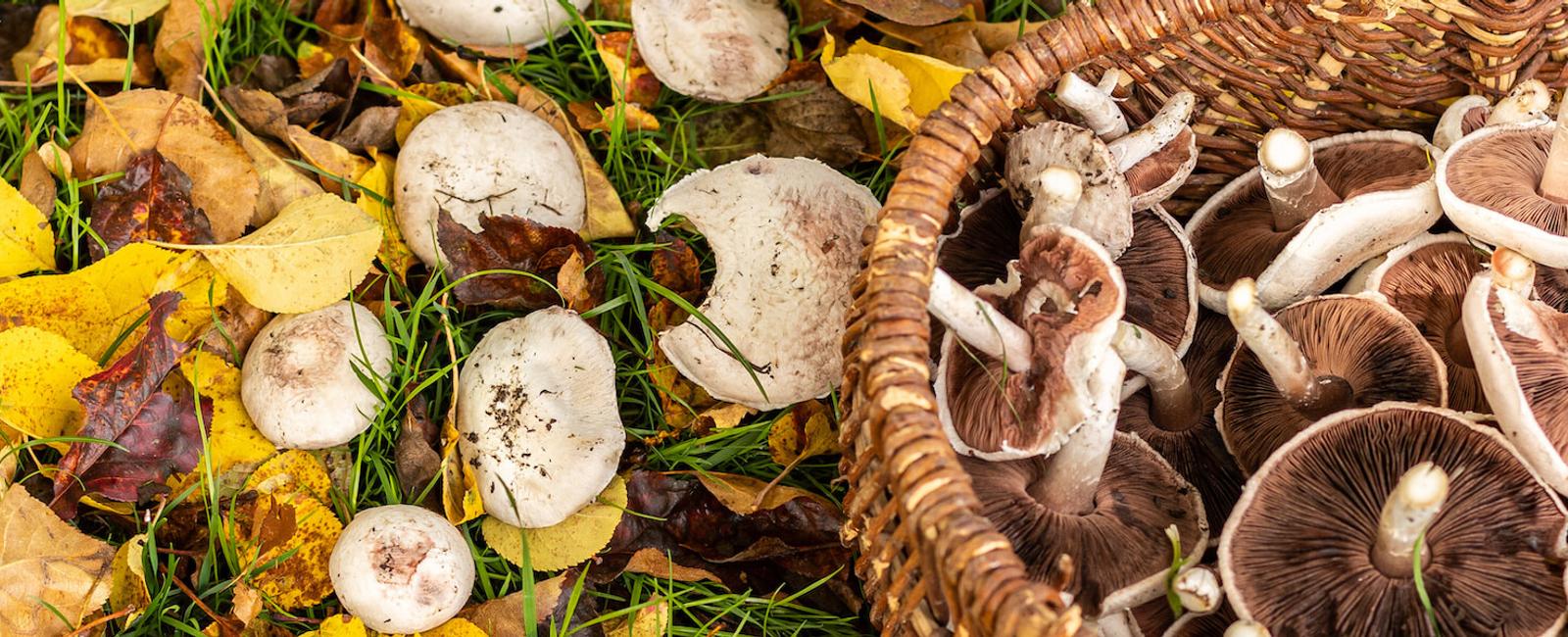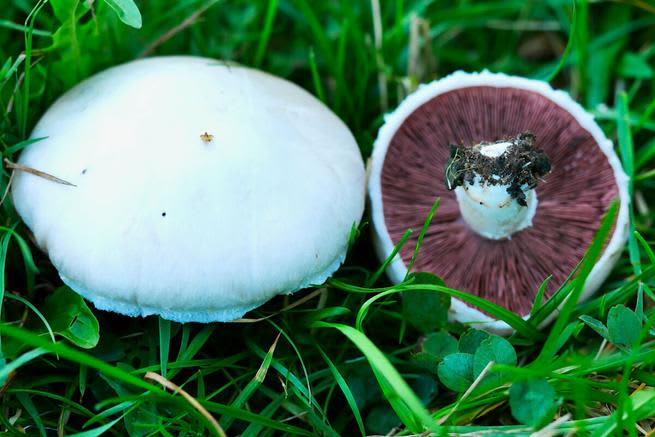

If you love white button mushrooms, you’ll be excited to learn there’s a wild mushroom that’s even more delicious—Agaricus campestris. Not only is this mushroom delicious, but it also offers a range of potential health benefits.
In this guide, you’ll learn all about Agaricus campestris mushrooms. We’ll talk about their appearance, where they grow, why correctly identifying this mushroom is essential, how to cook them, and much more.
What is agaricus campestris?
Agaricus campestris (its scientific name) mushrooms are known by their common names: meadow mushroom, field mushroom, prairie mushroom, or pink bottom mushroom. These gilled mushrooms are edible and closely related to the white button mushroom (Agaricus bisporus) (1).
The taxonomy for Agaricus campestris is as follows:
Kingdom: Fungi
Phylum: Basidiomycota
Class: Agaricomycetes
Order: Agaricales
Family: Agaricaceae
Genus: Agaricus
Species: A. campestris
Proper mushroom identification is essential with Agaricus campestris mushrooms, as there are several similar Agarics:
- Agaricus xanthodermus (A. xanthodermus): Also known as the yellow stainer, this mushroom is responsible for several poisonings, looking remarkably similar to both Agaricus bisporus and Agaricus campestris (2).
- Agaricus bitorquis (A. bitorquis): This similar species is edible and looks like Agaricus bisporus and Agaricus campestris. It grows in urban areas, along sidewalks and parks, and occasionally will poke through concrete and asphalt (3).
- Agaricus californicus (A.californicus): One to avoid, Agaricus californicus is mildly toxic, causing gastrointestinal upset. It will often display yellow staining when bruised (4).
- Agaricus arvensis (A. arvensis): Also known as the horse mushroom and found in fields and grassy areas preferred by Agaricus campestris, this edible species has white gills and chocolate brown spores (5).
There’s one more member of the Agaricus species you’ll want to be especially mindful of: Agaricus phalloides. Also called the death cap or destroying angel, this inedible mushroom is incredibly dangerous. While not all amanita mushrooms are toxic to humans, this one is (6). It is most dangerous in its early growth or button stage, when it closely resembles Agaricus campestris, and can cause liver and organ failure, leading to death (7).
What do agaricus campestris look like?
Agaricus campestris has a white cap—sometimes the mushroom caps will have fine scales—that are anywhere from just over an inch to nearly five inches in diameter. Its hemispheric caps will flatten as the mushroom matures.
The gills of this edible fungus also undergo a color transformation as the mushroom ages, starting with pink gills that gradually darken to a deep pink, then reddish brown, finally turning dark brown. Stems can range from an inch to nearly four inches in height (8).
Where do agaricus campestris grow?

Unlike some mushrooms that exclusively dwell in forests, you’re most likely to find Agaricus campestris mushrooms in fields or grassy areas after rainfall. This means they could be closer than you think, especially if you live in a suburban area. They’re lawn dwellers like puffball mushrooms (8). And don’t be surprised if you see them growing in Alpine meadows, as they are one of the few Agaricus species mushrooms that grow in both environments (9).
This widespread filed mushroom grows in North America, Europe, Asia, North Africa, Australia, and New Zealand (8).
Psst: You might also see Agaricus campestris mushrooms growing in a fairy ring. Also called elf rings or pixie rings, fairy rings are naturally occurring rings of mushrooms appearing on the forest floor that will continue to get bigger the older they get. You’ll likely see fairy rings in woodlands or grassy areas around late summer or early autumn (10).
Historical and traditional use of agaricus campestris mushrooms
For centuries, our ancestors have enjoyed wild mushrooms for their delightful flavor and remarkable medicinal properties. While we’re fortunate that many of these mushrooms have been well documented in traditional medicine schools, we don’t always have a clear paper trail to follow for each mushroom. As such, we cannot confirm whether Agaricus campestris played a prominent role in herbal or folk medicine practices.
However, we do know a little about its modern history. Carl Linnaeus, a Swedish botanist, was the first to record Agaricus campestris in 1753. In Latin, campestris means “of the field,” denoting where you’ll most likely see this mushroom (8).
Psst: You can explore a variety of mushrooms at the New York Botanical Garden, including jelly fungi, polypores, boletes, and gilled mushrooms like Agaricus campestris. What you’ll see may vary depending on the time of year. Still, you can expect to see between 40 and 50 mushrooms each season.
Health benefits of agaricus campestris mushrooms
Agaricus campestris isn’t as thoroughly studied as other mushroom species, so we don’t have as much information on its health benefits as other mushrooms.
That said, emerging research suggests Agaricus campestris may have the following health benefits:
- Antioxidant: One study found that Agaricus campestris can help offset the cellular damage associated with hydrogen peroxide.
- Anti-cancer: In vitro studies demonstrated this mushroom’s ability to induce cell death in both larynx and breast carcinoma cell lines.
- Anti-diabetic: Animal studies showed how agaricus campestris can positively influence glucose uptake and glucogenesis.
- Anti-microbial: Scientists have discovered extracts of Agaricus campestris can inhibit the growth of specific bacterial strains, including food-borne gram-positive bacterial strain Clostridium perfringens (1).
Ethically wildcrafting agarcius campestris mushrooms

Feeling ready to head out for some mushroom foraging? Before you do, it’s important to learn about the differences between foraging and ethical wildcrafting. Even though these may seem like the same thing, they can vary widely in their approach.
Most of the time, foraging is used as a general term for gathering wild foods (like nuts, seeds, berries, mushrooms, herbs, and plants). Ethical wildcrafting, on the other hand, is more specifically defined as harvesting local resources for medicinal needs.
One of the primary ways ethical wildcrafting distinguishes itself from foraging is through its mindful approach centering on the health of the local ecosystem and how to reduce the impact in the short and long term.
Learning the local area
Learning about the local area where you’ll be foraging is essential. Research whether you’ll need special permits or permissions to gather meadow mushrooms. You’ll also want to familiarize yourself with threatened or endangered mushroom species.
Equally important is being aware of a potentially poisonous lookalike. Be sure to consult a field guide for proper mushroom identification. And if you still aren’t sure, contact a trusted professional for further clarification.
Mushroom anatomy and proper harvesting
Practicing appropriate mushroom harvesting starts with having a keen understanding of mushroom anatomy. It’s easy (and common) to think what we see above ground is all of the mushroom, but that isn’t the case.
What we see in our local grocery stores or farmer’s markets are the fruiting bodies of a mushroom. Hiding just beneath the surface is a fascinating world where the other half of a mushroom’s anatomy exists, often without our knowledge.
The mycelium is a highly sophisticated communication network composed of delicate filaments called hyphae. Sometimes called the “wood wide web,” mushrooms communicate with each other by sending small electrical impulses along this network, conveying information about changes in the environment and whether predators are nearby.
Bring the appropriate tools when you’re ready to harvest your mushrooms. Whether you carefully cut the mushroom at the base of its stem or gently twist it free from the soil, aim to keep the mycelial network as intact as possible. Doing so can ensure a mushroom is able to grow again in the same place.
Ecosystem preservation
Remember that we’re sharing one of nature’s resources when gathering mushrooms. These humble little mushrooms are a wild food for deer, birds, insects, small mammals, and other critters. Gather only what you need and avoid overharvesting. Not only can it affect the local animal populations, but it may also throw the delicate balance of the local ecosystem off-kilter, resulting in imbalances that could take years to correct.
Once you’re back home, consider making a spore print from your mushrooms. Exactly what they sound like, a spore print is something you can use to cultivate your own mushrooms. You can simplify the process by starting with a grow kit or exploring mushroom forums to connect with other enthusiasts and learn more about how to begin growing your own mushrooms.
How can you enjoy agaricus campestris mushrooms?

These edible mushrooms are exceptionally versatile in the kitchen and are equally delightful in soups and stir-fries as they are sauteed. Here are some of our favorite recipes where you can easily incorporate Agaricus campestris mushrooms.
White wine pasta with mushrooms and leeks
When looking for an indulgent and satisfying recipe that makes clean-up a breeze (only one pot!) and is ready in 30 minutes, look no further than Food and Wine’s white wine pasta with mushrooms and leeks. While this recipe calls for cremini mushrooms, freshly gathered Agaricus campestris would make a lovely substitute. Feel free to turn this into a wild mushroom medley with the addition of chanterelles or morel mushrooms.
Wild mushroom risotto
Even if it seems intimidating, we invite you to try this delectable wild mushroom risotto from The Modern Proper. Butter, shallots, fresh thyme, cream, and dry white wine combine to create a savory dish brimming with umami flavor. Portobello mushrooms would also be delicious here, so feel free to experiment!
Mushroom larb
Larb is a type of meat salad hailing from Laos, and even though it’s typically meat-based, it lends itself exceptionally well to plant-based adaptations. So naturally, we’re big fans of a dish where mushrooms are the star ingredient, like they are here in the mushroom larb from The Woks of Life. We suggest mixing some Agaricus campestris mushrooms with the oyster mushrooms already in the recipe for a flavorful meal you can make in under an hour.
Agarcius campestris: An intriguing meadow mushroom
Far from boring, agaricus campestris mushrooms are so much more than plain white mushrooms. These flavorful shrooms, with their promising health benefits and delicious flavor, are a welcome addition to any meal and well worth an afternoon of gathering.
Keep up with us on shroomer for more mushroom happenings, including news and breakthroughs on medicinal and psychedelic mushrooms.
References
“Agaricus Campestris: The Ultimate Mushroom Guide.” n.d. 1101 Mushroom Identifications: The Ultimate Mushroom Library. https://ultimate-mushroom.com/edible/25-agaricus-campestris.html
“Yellow-Staining Mushroom– Agaricus Xanthodermus.” n.d. Royal Botanic Gardens Victoria. https://www.rbg.vic.gov.au/science/herbarium/yellow-staining-mushroom/
“Agaricus Bitorquis: The Ultimate Mushroom Guide.” n.d. 1101 Mushroom Identifications: The Ultimate Mushroom Library. https://ultimate-mushroom.com/edible/110-agaricus-bitorquis.html
“Agarcius Californicus.” n.d. Academic Accelerator. Accessed September 28, 2023. https://academic-accelerator.com/encyclopedia/agaricus-californicus
WTU Herbarium, Burke Museum, University of Washington. n.d. “Agaricus Arvensis - Burke Herbarium Image Collection.” Copyright (C) 2004-2023 WTU Herbarium, Burke Museum, University of Washington. https://burkeherbarium.org/imagecollection/taxon.php?Taxon=Agaricus%20arvensis
Schneider, S.M. 2014. “Mushrooms, Cyclopeptide.” In Elsevier EBooks, 409–11. https://doi.org/10.1016/b978-0-12-386454-3.00755-7
Adams, Cat. 2014. “The Most Dangerous Mushroom Is Spreading. Here’s How to Treat Poisoning.” Slate Magazine, February 10, 2014. https://slate.com/technology/2014/02/most-dangerous-mushroom-death-cap-is-spreading-but-poisoning-can-be-treated.html
“Agaricus Campestris.” n.d. Academic Accelerator. Accessed September 28, 2023. https://academic-accelerator.com/encyclopedia/agaricus-campestris
“Agaricus Campestris (Meadow Mushroom, Pink Bottom).” n.d. Copyright (C) 2023 by Coloradomushrooms.Com. https://www.coloradomushrooms.com/mushroom.php?id=8
Trust, Woodland. 2019. “What Is a Fairy Ring and What Causes Them? - Woodland Trust.” Woodland Trust. August 26, 2019. https://www.woodlandtrust.org.uk/blog/2019/08/what-is-a-fairy-ring/


